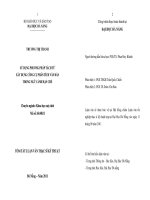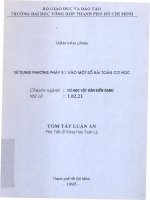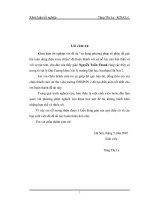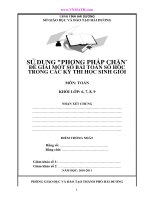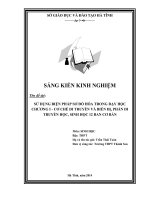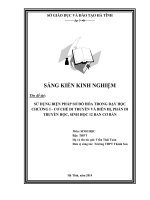- Trang chủ >>
- Nhóm halogen >>
- Flo
SỬ DỤNG PHƯƠNG PHÁP NHÂN TỬ LAGRANGE TRONG BÀI TOÁN TÌM GIÁ TRỊ LỚN NHẤT VÀ GIÁ TRỊ NHỎ NHẤT CỦA HÀM HAI BIẾN
Bạn đang xem bản rút gọn của tài liệu. Xem và tải ngay bản đầy đủ của tài liệu tại đây (551.2 KB, 4 trang )
<span class='text_page_counter'>(1)</span><div class='page_container' data-page=1>
<i>Nguyễn Thị Huệ </i> Tạp chí KHOA HỌC & CÔNG NGHỆ 172(12/1): 21 - 24
21
<b>USING METHOD OF LAGRANGE MULTIPLIERS </b>
<b>IN THE PROBLEM OF FINDING ABSOLUTE MAXIMUM AND MINIMUM </b>
<b>OF FUNTION OF TOW VARIABLES </b>
<b>Nguyen Thi Hue* </b>
<i>University of Technology - TNU </i>
SUMMARY
The problem of finding absolute maximum and minimum values of function of two variables on a
closed bounded set D have general method. However, when solving some problems, finding
<i>critical points on the boundary of D is difficult to put y= y (x) or x= x(y) to substitute into f(x, y) </i>
and to make the problem becomes complex. So, this article presents method of Lagrange
Multipliers to find critical points on the boundary of D when we solve absolute maximum and
minimum problems. Simultaneously, providing some illustrative examples to show the
effectiveness of this method, when finding the critical points on the boundary of D in the case of
<i>obtaining y=y(x) or x=x(y) from the boundary equation of D and substitute into f(x,y) difficultly. </i>
<i><b>Keywords: Absolute Maximum, absolute Minimum, function of tow variables, method of </b></i>
<i>Lagrange multipliers, critical point</i>
INTRODUCTION*
Finding absolute Maximum and Minimum
problems for the function of tow variables has
a general solution. However, some problems
<i>are difficult to obtain y=y(x) or x=x(y) and </i>
<i>substitute into f(x,y). Therefor, this article </i>
presents method of Lagrange multipliers to
<i>find critical points of f on the boundary of D </i>
in this case.
USING METHOD OF LAGRANGE
MULTIPLIERS IN THE PROBLEM OF
FINDING ABSOLUTE MAXIMUM AND
MINIMUM OF FUNTION OF TOW
VARIABLES
<b>Solution method </b>
<i><b>Problem. Find absolute maximum and </b></i>
<i>minimum of funtion z= f(x,y) on a closed </i>
bounded set D.
<i><b>Solution method [1],[4] </b></i>
<i>1. Find the values of f at the critical points of f </i>
in D by solving system of equations:
0 0
' 0
( )
' 0
<i>x</i>
<i>y</i>
<i>z</i>
<i>M</i> <i>D</i> <i>f M</i>
<i>z</i>
<sub></sub> <sub></sub> <sub></sub>
<sub></sub>
<i>2. Find the extreme values of f on the boundary </i>
<i>of D, assum that f(M1), f(M2),..., f(Mn). </i>
*<i><sub> Tel: 0976 909891, Email: </sub></i>
3. The largest of the values from steps 1 and 2 is
the absolute maximum value; the smallest of
these values is the absolute minimum value:
<i>Maxf= Max { f(M0), f(M1), f(M2),..., f(Mn)} </i>
<i>Minf= Min{ f(M0), f(M1), f(M2),..., f(Mn)} </i>
However, in step 2, some problems are
<i>difficult to obtain y=y(x) or x=x(y) and </i>
<i>substitute into f(x,y). We can use method of </i>
Lagrange multiplier to find critical points on
<i>the boundary of D as follows: </i>
<i>+ Setting the function: F(x,y)= f(x,y) + </i><i>g(x,y) </i>
<i>(g(x,y)=0 is the boundary equation of D) </i>
+ Solve system of equations to find critical
<i>points on the boundary of D: </i>
1 2
'
0
'
0
,
,...,
( , )
0
<i>x</i>
<i>y</i> <i>n</i>
<i>F</i>
<i>F</i>
<i>M M</i>
<i>M</i>
<i>g x y</i>
<sub></sub>
<sub></sub>
<sub></sub>
<b>Examples </b>
<i><b>Example 1. Find absolute maximum and </b></i>
minimum values of function
on a closed
bounded set D:
</div>
<span class='text_page_counter'>(2)</span><div class='page_container' data-page=2>
<i>Nguyễn Thị Huệ </i> Tạp chí KHOA HỌC & CƠNG NGHỆ 172(12/1): 21 - 24
22
+ Solve system of equations:
0 0
0
' 0 2 0
1
' 0 2 1 0
2
1 3
(0, ) ( )
2 4
<i>x</i>
<i>y</i>
<i>x</i>
<i>z</i> <i>x</i>
<i>z</i> <i>y</i> <i>y</i>
<i>M</i> <i>D</i> <i>f M</i>
<sub></sub> <sub></sub>
<sub></sub> <sub> </sub>
<sub></sub>
+ On the boundary of D
<i>x</i>
2
<i>y</i>
2
1
, wehave
<i>x</i>
2
1
<i>y</i>
2and2 2 2
(1
, ) 1
1
,
[ 1,1]
<i>f</i>
<i>y</i>
<i>y</i>
<i>y</i>
<i>y</i>
<i>y</i>
<i>y y</i>
This is an increasing funtion of y, so its
<i>minimum value is f(0,-1)=0 and its maximum </i>
<i>value is f(0,1)=2 </i>
We compare these values with the value
0
3
( )
4
<i>f M</i> at the critical point and conclude
<i>that the absolute maximum value is f(0,1)=2 </i>
<i>and the absolute minimum value is f(0,-1)=0 </i>
<i>In this example, obtaining y=y(x) or x=x(y) </i>
<i>and substitute into f(x,y) is very convenient. </i>
However, in step 2 we can use method of
Lagrange multipliers to find critical points on
the boundary as follows:
<i>+ Setting the function F(x,y)= x2 + y2 + y + </i>
<i>(x2+ y2-1) </i>
+ Solve system of equations:
2 2
2 2
'
0
2
2
0
'
0
2
1 2
0
1
1
<i>x</i>
<i>y</i>
<i>F</i>
<i>x</i>
<i>x</i>
<i>F</i>
<i>y</i>
<i>y</i>
<i>x</i>
<i>y</i>
<i>x</i>
<i>y</i>
<sub></sub>
<sub></sub>
<sub></sub>
<sub></sub>
<sub></sub>
<sub></sub>
<sub></sub>
<sub> </sub>
<sub></sub>
1
2
(0,1)
1
2
(0, 1)
3
2
<i>M</i>
<i>M</i>
<sub></sub>
<sub> </sub>
<sub></sub>
<sub></sub>
Comparing three values ,
<i>we have absolute maximum value is f(0, -1)= </i>
<i>2 at M1(0, 1) and absolute minimum value is </i>
<i>f(0, -1)=0 at M2(0, -1). </i>
To show the effectiveness of method of
<i><b>Lagrange multipliers, we consider the </b></i>
following example.
<i><b>Example 2. Find absolute maximum and </b></i>
minimum values of funtion
2 2
( , )
<i>z</i>
<i>f x y</i>
<i>x</i>
<i>y</i>
on the closed boundedset D:
<i>x</i> 2
2 <i>y</i> 2
2 9<i><b> [2]. </b></i><i><b>Solution </b></i>
+ Solve system of equations:
' 0 2 0 0
2 0 0
' 0
<i>y</i>
<i>x</i>
<i>z</i> <i>x</i> <i>x</i>
<i>y</i> <i>y</i>
<i>z</i>
<sub></sub> <sub></sub>
<sub></sub> <sub></sub>
0(0, 0) ( 0) 0
<i>M</i> <i>D</i> <i>f M</i>
+ On the boundary of D:
2
22 2 9
<i>x</i> <i>y</i>
We use method of Lagrage multipliersm.
+ Setting the function:
2
22 2
( , )
2
2
9
<i>F x y</i>
<i>x</i>
<i>y</i>
<sub></sub>
<i>x</i>
<i>y</i>
<sub></sub>
+ Solve system of equations:
2 2
'
0
'
0
(
2)
(
2)
9
<i>x</i>
<i>y</i>
<i>F</i>
<i>F</i>
<i>x</i>
<i>y</i>
<sub></sub>
<sub></sub>
2 2
2
2 (
2)
0
2
2 (
2)
0
(
2)
(
2)
9
<i>x</i>
<i>x</i>
<i>y</i>
<i>y</i>
<i>x</i>
<i>y</i>
<sub></sub>
2 2
(
)(1
)
0
2
2 (
2)
0
(
2)
(
2)
9
<i>x</i>
<i>y</i>
<i>y</i>
<i>y</i>
<i>x</i>
<i>y</i>
<sub></sub>
2 2
2 2
2
2 (
2)
0
(
2)
(
2)
9
1
2
2 (
2)
0
(
2)
(
2)
9
<i>x</i>
<i>y</i>
<i>y</i>
<i>y</i>
<i>x</i>
<i>y</i>
<i>y</i>
<i>y</i>
<i>x</i>
<i>y</i>
<sub></sub>
<sub></sub>
<sub></sub>
<sub></sub>
<sub></sub>
<sub></sub>
<sub></sub>
<sub></sub>
<sub></sub>
</div>
<span class='text_page_counter'>(3)</span><div class='page_container' data-page=3>
<i>Nguyễn Thị Huệ </i> Tạp chí KHOA HỌC & CÔNG NGHỆ 172(12/1): 21 - 24
23
1 1
2 2
5
5
5
,
,
3
2
2
1
1
1
,
,
3
2
2
<i>M</i>
<i>M</i>
<sub> </sub>
<sub></sub>
<sub></sub>
<sub></sub>
<sub></sub>
<sub></sub>
<sub></sub>
<sub></sub>
<sub></sub>
1 2
( ) 25, ( ) 1
<i>f M</i> <i>f M</i>
Comparing three values
0 1 2
( ), ( ), ( )
<i>f M</i> <i>f M</i> <i>f M</i> , we have absolute
maximum value is <i>f(M1)= </i> <i>25 </i> at
1
5
5
,
2
2
<i>M</i>
<sub></sub>
<sub></sub>
and absolute minimum value<i>is f(M0)=0 at M</i><sub>0</sub>(0, 0)<i>. </i>
<b>In Example 2, we see that when considering </b>
the boundary of domain D that obtain y=y(x)
or x=x(y) to subsitutec into f (x, y), the
problem becomes complex. So in this
example, using Lagrange multipliers to find
critical points on the boundary of D makes
the problem simpler and easier.
Notice that, we only focus critical points on
the boundary, so when solving the system of
equations above, we can not find the . To
see the advantages of this method, we
consider the following example.
<i><b>Example 3. Find absolute maximum and </b></i>
minimum values of
funtion
<i>z</i>
<i>f x y</i>
( , ) 1
<i>x</i>
2
<i>y</i>
2on theclosed bounded set D:
<i>x</i>1
2 <i>y</i>1
2 1<i><b>Solution </b></i>
+ Solve system of equations:
' 0 2 0 0
2 0 0
' 0
<i>y</i>
<i>x</i>
<i>z</i> <i>x</i> <i>x</i>
<i>y</i> <i>y</i>
<i>z</i>
<sub></sub> <sub></sub>
<sub></sub> <sub></sub> <sub></sub>
0(0, 0) ( 0) 1
<i>M</i> <i>f M</i>
+ On the boundary of D:
2
21 1 1
<i>x</i> <i>y</i>
We use method of Lagrage multipliers.
+ Setting the function:
2
22 2
( , ) 1 1 1 1
<i>F x y</i> <i>x</i> <i>y</i>
<sub></sub> <i>x</i> <i>y</i> <sub></sub>
+ Solve system of equations:
2 2
' 0
' 0
( 1) ( 1) 1
<i>x</i>
<i>y</i>
<i>F</i>
<i>F</i>
<i>x</i> <i>y</i>
<sub></sub>
<sub></sub>
2 2
2 2 ( 1) 0
2 2 ( 1) 0
( 1) ( 1) 1
<i>x</i> <i>x</i>
<i>y</i> <i>y</i>
<i>x</i> <i>y</i>
<sub></sub>
2 2
( )( 1) 0
2 2 ( 1) 0
( 1) ( 1) 1
<i>x</i> <i>y</i>
<i>y</i> <i>y</i>
<i>x</i> <i>y</i>
<sub></sub>
2 2
2 2
2 2 ( 1) 0
( 1) ( 1) 1
1
2 2 ( 1) 0
( 1) ( 1) 1
<i>x</i> <i>y</i>
<i>y</i> <i>y</i>
<i>x</i> <i>y</i>
<i>y</i> <i>y</i>
<i>x</i> <i>y</i>
<sub></sub> <sub></sub> <sub></sub> <sub></sub>
<sub> </sub>
<sub></sub>
<sub></sub> <sub></sub> <sub></sub> <sub></sub>
1
2
2 1 2 1
,
2 2
2 1 2 1
,
2 2
<i>M</i>
<i>M</i>
<sub></sub> <sub></sub>
<sub></sub> <sub></sub>
<sub></sub> <sub></sub>
<sub></sub> <sub></sub>
1 2
(
)
2 2 2, (
)
2 2 2
<i>f M</i>
<i>f M</i>
Comparing three values
0 1 2
( ), ( ), ( )
<i>f M</i> <i>f M</i> <i>f M</i> , we have absolute
<i>maximum value is f(M2)= </i>
2 2 2
<sub> at </sub>2
2 1 2 1
,
2 2
<i>M</i> <sub></sub> <sub></sub>
and absolute
<i>minimum value is f(M1)= </i>
2 2 2
at1
2 1 2 1
,
2 2
<i>M</i> <sub></sub><sub></sub> <sub></sub><sub></sub>
<i>. </i>
Finally, we consider the following example to
see the great effect of method of Lagrange
multipliers.
<i><b>Example 4. Find absolute maximum and </b></i>
minimum values of
</div>
<span class='text_page_counter'>(4)</span><div class='page_container' data-page=4>
<i>Nguyễn Thị Huệ </i> Tạp chí KHOA HỌC & CƠNG NGHỆ 172(12/1): 21 - 24
24
+ Solve system of equations:
' 0 2 4 0 2
2 4 0 2
' 0
<i>y</i>
<i>x</i>
<i>z</i> <i>x</i> <i>x</i>
<i>y</i> <i>y</i>
<i>z</i>
<sub></sub> <sub></sub>
<sub> </sub> <sub></sub>
0( 2, 2) ( 0) 8
<i>M</i> <i>D</i> <i>f M</i>
+ On the boundary of D: <i><sub>x</sub></i>2<sub></sub><i><sub>y</sub></i>2 <sub></sub><sub>9</sub>
We use method of Lagrage multipliers
+ Setting the function:
2 2 2 2
( , ) 4 4 9
<i>F x y</i> <i>x</i> <i>y</i> <i>x</i> <i>y</i> <i>x</i> <i>y</i>
+ Solve system of equations:
2 2
' 0
' 0
9
<i>x</i>
<i>y</i>
<i>F</i>
<i>F</i>
<i>x</i> <i>y</i>
<sub></sub>
<sub></sub>
2 2
2 4 2 0
2 4 2 0
9
<i>x</i> <i>x</i>
<i>y</i> <i>y</i>
<i>x</i> <i>y</i>
<sub></sub>
<sub></sub> <sub></sub>
2 2
( )( 1) 0
2 4 2 0
9
<i>x</i> <i>y</i>
<i>y</i> <i>y</i>
<i>x</i> <i>y</i>
<sub></sub>
<sub></sub> <sub></sub>
2 2
2 2
2 4 2 0
9
1
2 4 2 0
9
<i>x</i> <i>y</i>
<i>y</i> <i>y</i>
<i>x</i> <i>y</i>
<i>y</i> <i>y</i>
<i>x</i> <i>y</i>
<sub> </sub> <sub></sub>
<sub></sub> <sub></sub>
<sub> </sub>
<sub></sub>
<sub></sub> <sub></sub>
1
2
3 3
,
2 2
3 3
,
2 2
<i>M</i>
<i>M</i>
<sub></sub>
<sub></sub> <sub></sub>
<sub></sub> <sub></sub>
<sub></sub> <sub></sub>
1 2
(
)
9 12 2, (
)
9 12 2
<i>f M</i>
<i>f M</i>
Comparing three values
0 1 2
( ), ( ), ( )
<i>f M</i> <i>f M</i> <i>f M</i> , we have absolute
<i>maximum value is f(M2)= </i>
9 12 2
<sub> at </sub>2
3
3
,
2
2
<i>M</i>
<sub></sub>
<sub></sub>
and absolute minimum<i>value is f(M0)= -8 at M</i><sub>0</sub>( 2, 2) <i>.</i>
REFERENCES
<i>1. Ôn Ngũ Minh (2012), Bài giảng Toán 3, Đại </i>
học KTCN Thái Ngun.
2. Nguyễn Đình Trí, Tạ Văn Đĩnh, Nguyễn Hồ
<i>Quỳnh (2004), Toán học cao cấp, Tập 3 – Phép </i>
<i>tính Giải tích nhiều biến số, Nxb Giáo dục. </i>
<i>3. James Stewart (2010), Multivariable Calculus, </i>
<i>Seventh edition, </i>Cengage Learning.
<i>4. Jean-Marie Monier (2003), Giáo trình Tốn tập </i>
<i>2 – Giải tích 2, Nxb Giáo dục. </i>
TĨM TẮT
<b>SỬ DỤNG PHƯƠNG PHÁP NHÂN TỬ LAGRANG TRONG BÀI TỐN TÌM GIÁ </b>
<b>TRỊ LỚN NHẤT VÀ GIÁ TRỊ NHỎ NHẤT CỦA HÀM HAI BIẾN </b>
<b>Nguyễn Thị Huệ*</b>
<i>Trường Đại học Kĩ thuật Cơng nghiệp - ĐH Thái Ngun </i>
Bài tốn tìm giá trị lớn nhất, giá trị nhỏ nhất của hàm hai biến trên tập đóng D đã có phương pháp
giải chung. Tuy nhiên, khi giải một số bài toán, việc tìm điểm tới hạn trên biên của D bằng cách
rút y= y(x) hoặc x= x(y) để thay vào hàm f(x,y) là rất khó khăn hoặc làm cho bài tốn trở nên phức
tạp hơn. Vì vậy bài báo này trình bày phương pháp nhân tử Lagrang để tìm điểm tới hạn trên biên
của D khi giải bài toán tìm giá trị lớn nhất, giá trị nhỏ nhất. Đồng thời đưa ra một số ví dụ minh
họa cho thấy tính hiệu quả của phương pháp này khi tìm điểm tới hạn trên biên của D, mà việc rút
y theo x hoặc x theo y để thay vào hàm f(x,y) gặp khó khăn.
<i><b>Từ khóa: Giá trị lớn nhất, giá trị nhỏ nhất, hàm hai biến, phương pháp nhân tử Lagrang, điểm tới hạn </b></i>
<i><b>Ngày nhận bài: 01/9/2017; Ngày phản biện: 25/9/2017; Ngày duyệt đăng: 16/10/2017</b></i>
</div>
<!--links-->
